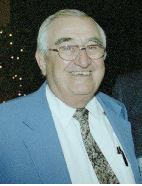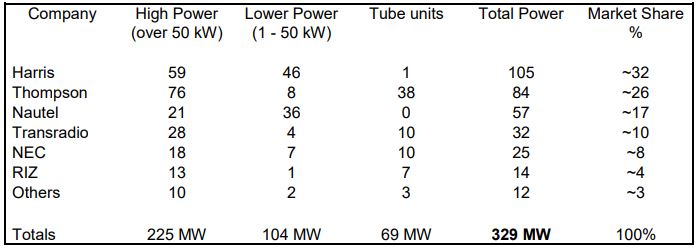How and Why Quincy, IL Became the Digital Capitol of the World Part 4 – Digital Rules RF and AF

[March 2010 – September 2011] As we bring Tom Yingst’s series to a conclusion, he helps explain how it was that digital audio and transmission technologies, often coming from Quincy, IL, really became the mainstream. The reduction of system noise and increased transmission efficiencies have made major changes in how broadcast facilities are built and operated.
As the 1990s progressed, improvements in digital audio and transmission began to converge in increased ways.
The Fight For Market Share
Led by the Quincy manufacturers, solid-state transmitters had proven to have outstanding performance and extraordinary reliability. They sold quite well around the world, at power levels to 1,000 kW and above (Harris had sold some 600 DX transmitters by 1995). This market characteristic allowed Quincy sales and production to look very good but, in fact, it should have grown even more.
Any great concept must be produced at a competitive price and must be ready to handle the competition which will develop. Interestingly, at the same time international competition began to ramp up, a strong broadcast market in the USA caused some slippage in attention to the international market, allowing competitors to get a stronghold in the worldwide market that Quincy felt belonged to it.
The only response is to continually improve and produce reliability units in a highly effective, cost-controlled factory setting. Quincy did remain competitive, seeking to regain its worldwide marketing leadership. Furthermore, it had new products to introduce.
A New Line
A completely digital approach was developed in the US for AM & FM transmission, promising FM-like audio on AM, and multipath-free FM. The new system called IBOC (In Band, On Channel) would stimulate production of AM & FM transmitters in Quincy in the early 2000’s as well as other locations. But the dominant part of the US-produced expansion was in Quincy, thus holding the Digital Capital of the World designation.
Adopted by the FCC, IBOC was given a strong stimulus by a series of grants from the Corporation for Public Broadcasting to the NPR (National Public Radio) stations. A welcome side-effect to this push to digital transmission was the need for stations to upgrade their transmitter plants, especially on AM, for the wider, flatter bandwidths needed for the digital signals to get out. From 1 kW to 50 kW, Quincy benefitted from the resurgent US transmitter market. Today FM digital is taking the lead.
Also in the late 1990s, an international digital system was developed, called DRM (Digital Radio Mondale), involving all the world’s major transmitter producers. Developed for AM/LW/SW, this full and flexible digital system has now been adapted to FM. Further development of DRM will have a dramatic effect on keeping Quincy the digital capital of the world in the future years and will be a big reason for renewed and increased International sales.
A Lot of Solid-State Watts
As noted, Harris has had a major part of the worldwide MW transmitter market since 1988. Indeed, until recently, Quincy provided as much as 45-50% of the worldwide solid state AM/LW market despite very strong international competition.
Since 1995, solid-state transmitters have taken over the AM/LW market. In fact, from 1988 through the spring of 2009, the total power of these transmitters installed totals almost 300 megawatts for some 16,000 units worldwide (5,000 in the US), including over 1600 units – ranging between 10 kW and 2000 kW – from Harris alone.

An estimation of the number of MW and LW transmitters installed
worldwide between 1988 and 2011 by all the major export suppliers.
(powers are in megawatts)
As a possible look at things to come, in the past few years, Broadcast Electronics has been broadening their product line base in Quincy, seeking to take a share of this market with the introduction of 25 kW, 50 kW, and 100 kW digital-ready AM transmitters.
Another reason many are predicting a bright future as the digital revolution continues is that only a small part of the total worldwide transmitter base has been upgraded to the new digital concepts – thus setting the stage for continued growth for AM/FM/LW in Quincy, keeping it the digital capital of the world.
Why Digital is Better
The companies based in Quincy continue to enhance their products and develop advances in the digital technology and manufacturing methods. Let us take a moment and recall the benefits we have achieved thus far in the AM and LW products:
- Very high transmitter overall efficiency – low AC power.
- Wide bandwidth audio systems.
- Extraordinary reliability.
- Extremely stable phase and amplitude characteristics.
- Very fast payback on initial investment due to the high power efficiency.
- Very low operating costs, due to the high reliability.
- Digital techniques can allow operations at a much lower average power for the same coverage.
- Soft failure techniques-high reliability.
- Much higher and stable sideband power during positive modulations.
- Higher customer satisfaction.
- Better quality reception for listeners.
- Essentially ready for the new DRM & IBOC approaches with very little changes.
With modern manufacturing systems implemented and upgraded, all this is going to continue happening. Of course, these successes can only occur with the true dedication of a large number of people who made major contributions to their respective areas. One acknowledgement of the quality of workers in Quincy is the increase in companies taking advantage of doing business in Quincy – Nautel being one of the most recent.
Shortwave Activity
Although we have traced a great deal of solid-state activity was in the AM and LW bands, with more recent gains on FM, shortwave was not one of the initial benefactors of the digital revolution.
There was a huge upgrading of shortwave transmission sites from about 1980 – 1995, but at that time, solid-state approaches like the DX transmitter line did not develop for the high power SW transmitters because of the high non-competitive cost to produce the solid-state RF stages.
Nevertheless, that did not stop the SW stations from upgrading their transmitters. During that fifteen year period, over 600 transmitter plants were upgraded, representing some 160 megawatts of capacity (an amazing average of some 300 kW), with Continental Electronics a major supplier.
Large numbers of PSM (Pulse Step Modulation) in solid-state format were sold in the 1980’s for SW. These units are mostly ready for the new DRM digital approach with a little modification. But it was not until the last couple of years that solid-state devices for those frequencies were cost-effective.
During those years, the major AM/LW upgrade proceeded, and the industry developed the technology that now has extended to shortwave.
Looking Ahead
Quincy became the “Digital Transmitter Capital of the World” starting with Gates Radio in 1922 and has seen continued growth technically and physically since that time. Thousands of transmitters and associated equipment were manufactured there and installed worldwide.
As the industry develops a new technology like digital with all its advantages, it sets the stage for a bright future – in this case for AM/LW/SW as only a portion of the worldwide base has been upgraded. For example, within the US broadcast industry, there still are many transmitters older than 30 to 40 years in use daily as Main Transmitters – and these will need to be upgraded.
I was fortunate to work with the Quincy companies as a supplier for over twenty years prior to 1988, for about 8½ years directly with the Harris Broadcast Division in Quincy, and as a part-time consultant after my full retirement in 1996. For well over three decades in my Front Row seat, I had the opportunity to see all the events and developments we have discussed with my own eyes, and be directly involved in them.
Part of the bright Quincy Digital Future revolves around the fact that digital systems like DRM for MW at present require high peak power – but the average power can be greatly reduced for the same or better coverage (as much as a factor of five, or -7 dB). This may mean that the overall average power sold each year may go down with the sales of the more sophisticated digital transmitters, but the numbers per year projected should be the same. So the income will continue to have very excellent potential.
All of these developments plus the development of receivers to cover DRM & IBOC systems bands sets the stage for a bright future in the worldwide broadcast industry (AM/SW/LW/FM). And this future will provide the foundation for Quincy to continue into the future as the Digital Transmitter Capital of the World – holding that position for some time to come.
– – –
Now retired, Tom Yingst was right in the middle of the broadcast industry as it moved from analog to transistor to microprocessor. Contact Tom at TEY1926@aol.com
